北京化工大学:《无机化学》课程电子教案(教学课件,2011)Chapter 02 Thermochemistry
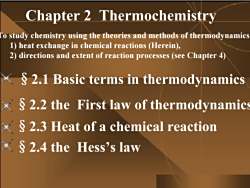
Chapter 2 Thermochemistry o study chemistry using the theories and methods of thermodynamics 1)heat exchange in chemical reactions (Herein), 2)directions and extent of reaction processes(see Chapter 4) X 2.1 Basic terms in thermodynamics x 2.2 the First law of thermodynamics x'2.3 Heat of a chemical reaction x§2.4 the Hess'slaw
Chapter 2 Thermochemistry §2.1 Basic terms in thermodynamics §2.3 Heat of a chemical reaction To study chemistry using the theories and methods of thermodynamics 1) heat exchange in chemical reactions (Herein), 2) directions and extent of reaction processes (see Chapter 4) §2.2 the First law of thermodynamic s §2.4 the Hess’s law
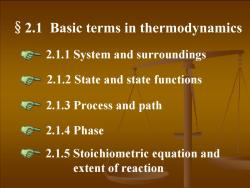
2.1 Basic terms in thermodynamics -2.1.1 System and surroundings 2.1.2 State and state functions 2.1.3 Process and path =2.1.4 Phase 2.1.5 Stoichiometric equation and extent of reaction
§2.1 Basic terms in thermodynamics 2.1.1 System and surroundings 2.1.5 Stoichiometric equation and extent of reaction 2.1.4 Phase 2.1.3 Process and path 2.1.2 State and state functions

2.1.1 System and surroundings System:the specific part of the universe we are studying Surroundings:the rest of the universe outside the system Open system:a system can exchange mass and energy with its surroundings Closed system:a closed system exchanges energy but not matter with its surroundings Isolated system:an isolated system exchange neither mass nor energy with its surroundings
2.1.1 System and surroundings System :the specific part of the universe we are studying Surroundings :the rest of the universe outside the system Open system: a system can exchange mass and energy with its surroundings Closed system: a closed system exchanges energy but not matter with its surroundings Isolated system: an isolated system exchange neither mass nor energy with its surroundings
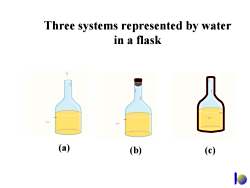
Three systems represented by water in a flask (a) (b) (c) lo
Three systems represented by water in a flask (a) (b) (c)
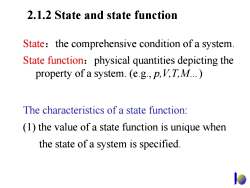
2.1.2 State and state function State:the comprehensive condition of a system. State function:physical quantities depicting the property of a system.(e.g.,p,V,T;M...) The characteristics of a state function: (1)the value of a state function is unique when the state of a system is specified
2.1.2 State and state function State:the comprehensive condition of a system. State function:physical quantities depicting the property of a system. (e.g., p,V,T,M… ) The characteristics of a state function: (1) the value of a state function is unique when the state of a system is specified
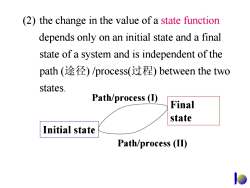
(2)the change in the value of a state function depends only on an initial state and a final state of a system and is independent of the path(途径)/processt(过程)between the two states. Path/process (I) Final state Initial state Path/process (II)
(2) the change in the value of a state function depends only on an initial state and a final state of a system and is independent of the path (途径) /process(过程) between the two states. Initial state Final state Path/process (II) Path/process (I)
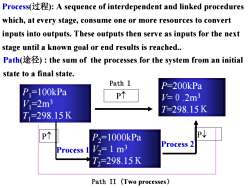
Process(过程):A sequence of interdependent and linked procedures which,at every stage,consume one or more resources to convert inputs into outputs.These outputs then serve as inputs for the next stage until a known goal or end results is reached.. Path(途径):the sum of the processes for the system from an initial state to a final state. Path I P=200kPa P=100kPa P个 =0.2m3 V=2m3 T=298.15K T=298.15K P个 P,=1000kPa P、 Process 12=1 m3 Process 2 T2=298.15K Path II (Two processes)
P1=100kPa V1=2m3 T1=298.15K P2=1000kPa V2=1m3 T2=298.15K P↑ P=200kPa V=0.2m3 T=298.15K 始态 Path II (Two processes) Path I Process(过程): A sequence of interdependent and linked procedures which, at every stage, consume one or more resources to convert inputs into outputs. These outputs then serve as inputs for the next stage until a known goal or end results is reached.. Path(途径) : the sum of the processes for the system from an initial state to a final state. Process 1 P↑ Process 2 P↓
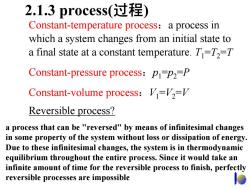
2.1.3 process(过程) Constant-temperature process:a process in which a system changes from an initial state to a final state at a constant temperature.T=T2=T Constant-pressure process:p-p2=P Constant-volume process:V=12=V Reversible process? a process that can be "reversed"by means of infinitesimal changes in some property of the system without loss or dissipation of energy. Due to these infinitesimal changes,the system is in thermodynamic equilibrium throughout the entire process.Since it would take an infinite amount of time for the reversible process to finish,perfectly reversible processes are impossible
2.1.3 process(过程 ) Constant-temperature process:a process in which a system changes from an initial state to a final state at a constant temperature. T1 = T2 = T Constant-pressure process:p 1 =p 2 =P Constant-volume process:V1 = V2 = V Reversible process? a process that can be "reversed" by means of infinitesimal changes in some property of the system without loss or dissipation of energy. Due to these infinitesimal changes, the system is in thermodynamic equilibrium throughout the entire process. Since it would take an infinite amount of time for the reversible process to finish, perfectly reversible processes are impossible
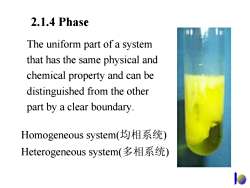
2.1.4 Phase The uniform part of a system that has the same physical and chemical property and can be distinguished from the other part by a clear boundary. Homogeneous system(均相系统) Heterogeneous system(多相系统)
2.1.4 Phase Homogeneous system(均相系统) Heterogeneous system(多相系统) The uniform part of a system that has the same physical and chemical property and can be distinguished from the other part by a clear boundary
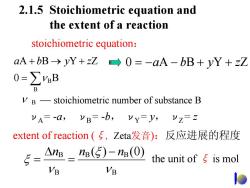
2.1.5 Stoichiometric equation and the extent of a reaction stoichiometric equation: aA+bB→yY+zZ→0=-aA-bB+yY+zZ 0=∑ygB V B -stoichiometric number of substance B vA=-a,vB=-b,vy=y, V7=Z extent of reaction(5,Zeta发音):反应进展的程度 5= △nB_nB(5)-nB(O) the unit ofξis mol VB VB
2.1.5 Stoichiometric equation and the extent of a reaction ν B — stoichiometric number of substance B stoichiometric equation: ν A= -a , ν B= -b , ν Y= y , ν Z= z B B B B B ( ) ( 0 ) ν ξ ν ξ n n − n = Δ = extent of reaction ( ξ, Zeta发音 ):反应进展的程度 the unit of ξ is mol = ∑ + → + B 0 B B A B Y Z ν a b y z 0 = − a A − b B + y Y + z Z
按次数下载不扣除下载券;
注册用户24小时内重复下载只扣除一次;
顺序:VIP每日次数-->可用次数-->下载券;
- 北京化工大学:《无机化学》课程电子教案(教学课件,2011)Chapter 01 前言 Preface(负责人:周云山).pdf
- 北京化工大学:《无机化学》课程电子教案(试卷习题)第十六-十七综合自我练习题及答案.pdf
- 北京化工大学:《无机化学》课程电子教案(试卷习题)第十六章自我练习题及答案.pdf
- 北京化工大学:《无机化学》课程电子教案(试卷习题)第十七章自我练习题及答案.pdf
- 北京化工大学:《无机化学》课程电子教案(试卷习题)第十五章自我练习题及答案.pdf
- 北京化工大学:《无机化学》课程电子教案(试卷习题)第十三-十四章综合自我练习题及答案.pdf
- 北京化工大学:《无机化学》课程电子教案(试卷习题)第十四章自我练习题及答案.pdf
- 北京化工大学:《无机化学》课程电子教案(试卷习题)第十二章自我练习题及答案.pdf
- 北京化工大学:《无机化学》课程电子教案(试卷习题)第十三章自我练习题及答案.pdf
- 北京化工大学:《无机化学》课程电子教案(试卷习题)第十章自我练习题及答案.pdf
- 北京化工大学:《无机化学》课程电子教案(试卷习题)第十一章自我练习题及答案.pdf
- 北京化工大学:《无机化学》课程电子教案(试卷习题)第八章自我练习题及答案.pdf
- 北京化工大学:《无机化学》课程电子教案(试卷习题)第九章自我练习题及答案.pdf
- 北京化工大学:《无机化学》课程电子教案(试卷习题)第七章自我练习题及答案.pdf
- 北京化工大学:《无机化学》课程电子教案(试卷习题)第四章自我练习题及答案.pdf
- 北京化工大学:《无机化学》课程电子教案(试卷习题)第六章自我练习题及答案.pdf
- 北京化工大学:《无机化学》课程电子教案(试卷习题)第五章自我练习题及答案.pdf
- 北京化工大学:《无机化学》课程电子教案(试卷习题)第二章自我练习题及答案.pdf
- 北京化工大学:《无机化学》课程电子教案(试卷习题)第三章自我练习题及答案.pdf
- 北京化工大学:《无机化学》课程电子教案(试卷习题)作业习题(中英文)安排及部分答案.pdf
- 北京化工大学:《无机化学》课程电子教案(教学课件,2011)Chapter 03 Chemical kinetics.pdf
- 北京化工大学:《无机化学》课程电子教案(教学课件,2011)Chapter 05 Acid-Base Equilibrium.pdf
- 北京化工大学:《无机化学》课程电子教案(教学课件,2011)Chapter 04 Chemical equilibria, entropy and Gibbs function.pdf
- 北京化工大学:《无机化学》课程电子教案(教学课件,2011)Chapter 10 Solid Structure.pdf
- 北京化工大学:《无机化学》课程电子教案(教学课件,2011)Chapter 11 Coordination Compound Structures.pdf
- 北京化工大学:《无机化学》课程电子教案(教学课件,2011)Chapter 12 The s-Block Elements.pdf
- 北京化工大学:《无机化学》课程电子教案(教学课件,2011)Chapter 06 Precipitation-Solubility Equilibria.pdf
- 北京化工大学:《无机化学》课程电子教案(教学课件,2011)Chapter 08 Atomic Structure.pdf
- 北京化工大学:《无机化学》课程电子教案(教学课件,2011)Chapter 13 The p-block elements(Ⅰ).pdf
- 北京化工大学:《无机化学》课程电子教案(教学课件,2011)Chapter 07 Redox Reactions and Base of Electrochemistry.pdf
- 北京化工大学:《无机化学》课程电子教案(教学课件,2011)Chapter 09 Molecular Structure.pdf
- 北京化工大学:《无机化学》课程电子教案(教学课件,2011)Chapter 17 The d-block elements(Ⅱ).pdf
- 北京化工大学:《无机化学》课程电子教案(教学课件,2011)Chapter 14 p-block elements(Ⅱ).pdf
- 北京化工大学:《无机化学》课程电子教案(教学课件,2011)Chapter 15 p-block elements(Ⅲ).pdf
- 北京化工大学:《无机化学》课程电子教案(教学课件,2011)Chapter 16 The d-block elements(Ⅰ).pdf
- 北京化工大学:《无机化学》课程电子教案(教学课件,2012)Chapter 2 Thermochemistry.pdf
- 北京化工大学:《无机化学》课程电子教案(教学课件,2012)Chapter 5 Acid-Base Equilibrium.pdf
- 北京化工大学:《无机化学》课程电子教案(教学课件,2012)Chapter 6 Precipitation-Solubility Equilibria.pdf
- 北京化工大学:《无机化学》课程电子教案(教学课件,2012)Chapter 7 Redox Reactions and the Base of Electrochemistry.pdf
- 北京化工大学:《无机化学》课程电子教案(教学课件,2012)Chapter 8 Atomic Structure.pdf
